Last Updated on January 21, 2024 by Greg Gillson
I’ve put this resource together for you to answer your question: What birds are in my backyard in Maine?
This article lists and discusses the identification of the most common birds in your backyard. The birds chosen in this article are compiled from actual data from the citizen science program eBird. Thus, it is more accurate than some other similar articles you may find on the web. I provide pictures of each bird species mentioned. I tell how to attract them to your backyard.
These are the most common backyard birds in Maine:
- American Crow
- Black-capped Chickadee
- American Goldfinch
- Blue Jay
- Song Sparrow
- Mourning Dove
- American Robin
- Northern Cardinal
- White-breasted Nuthatch
- Downy Woodpecker
- Tufted Titmouse
- Red-breasted Nuthatch
- Red-winged Blackbird
- Hairy Woodpecker
- Dark-eyed Junco
- Gray Catbird
- Eastern Phoebe
- Chipping Sparrow
- White-throated Sparrow
- European Starling
- Common Grackle
- Red-eyed Vireo
- Cedar Waxwing
- Barn Swallow
Maine Birds and Birding in Maine State
eBird lists over 450 types of birds as occurring in the state of Maine.
The most common bird in Maine: the most frequently seen bird in the state is American Crow. It is reported on 49% of bird watching lists.
If you are serious about knowing the birds native to Maine, then check out eBird for Maine. It has recent sightings and photos, illustrated checklists with weekly abundance bar charts for state, counties, and individual hotspots of the best birding locations.
If you want to know about other people interested in birds in your area, join a local bird group. The American Birding Association maintains a list of bird watching clubs for each state.
Maine Bird Identification
This section is the species accounts. These are designed to help you to recognize birds you see in your backyard. I have used eBird to select the birds that are most common. “Common” means the birds seen most often throughout the year, not necessarily the most numerous.
Each species account starts with a photograph. In the identification section I am using size and shape and bill type before considering the color or patterns on the birds. I find these more reliable when trying to identify an unknown bird. Pay attention to body and tail shape and especially bill shape of birds you see, not just plumage color.
In the section on bird feeders and foods I tell how to attract each species. Not all types of backyard birds will come to feeders. But all backyard birds can be attracted with water. So don’t forget to add a birdbath to your bird feeding station.
Do you live in northern Maine? Southern Maine?
To appear in this article, most birds are widely distributed throughout the state and are often year-round residents. However, for those birds that are more localized in place or time, I list the general region and seasonality. Please see the section following these species accounts for the lists of common species by season.
Even if a species is found in a general area, they occur only in the habitat they prefer. So, the exact habitat of your neighborhood is important for the presence of absence of certain kinds of birds.
1. American Crow (Corvus brachyrhynchos)
This larger all-black bird is common in cities and country. Its cawing call is familiar to most people.
 |
| American Crow. Greg Gillson. |
Range in Maine: American Crows are summer residents throughout Maine, year-round residents in southern Maine.
Identification: This is a key species for comparing with an unknown bird.
Size: About 17-1/2 inches long from bill tip to tail tip, though there is much size variation throughout its range. Larger than blackbirds and grackles. Smaller than ravens.
Shape: Thick neck, large head, rather short square-ended tail. Longer legs. In flight has rounded wing tips with each primary feather separated from others forming “fingers.”
Bill: As long as head, thick, black.
Color: Glossy black throughout.
Habitat, range & behavior: They prefer open areas with trees, fields, farms, cities.
They are common across most of the United States lower-48, except in the desert southwest. They move into southern Canada in summer.
They gather in evening communal roosts in large flocks that may number into the thousands and then move out at dawn into the surrounding area.
Food and feeder preference: Omnivorous, American Crows feed on large insects, grain, small mammals, carrion. You probably don’t want these large entirely black birds in your backyard feeders. So don’t feed table scraps to birds.
2. Black-capped Chickadee (Poecile atricapillus)
This is a common backyard bird in the northern half of the United States.
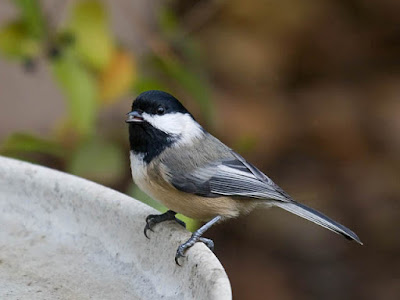 |
| Black-capped Chickadee. Greg Gillson |
Range in Maine: Black-capped Chickadees are year-round residents throughout Maine.
Identification:
Size: Chickadees are small birds, the same general size as an American Goldfinch.
Shape: Round body, big round head, long tail with rounded tip.
Bill: Short, straight, stout.
Color: Gray above, buffy below. Black cap and bib with white lower face. White edges on wing feathers.
Habitat, range & behavior: Deciduous and mixed forests.
They range from the northern half of the United States, southern half of Canada, and most of Alaska.
Small flocks flit actively from tree to tree acrobatically gleaning insects from twig tips. In winter chickadees make up the core of mixed-species flocks also containing nuthatches, kinglets, creepers, woodpeckers and others.
Food and feeder preference: Seeds, insects, berries. They eat at tube, hopper and tray feeders. They love black oil sunflower seeds and suet.
You may like my in-depth article on attracting Black-capped Chickadees.
3. American Goldfinch (Spinus tristis)
A beautiful tiny finch familiar to many in it’s bright yellow summer plumage. Colloquially called a “wild canary.”
 |
| American Goldfinch. Greg Gillson |
Range in Maine: American Goldfinches are summer residents throughout Maine, year-round residents in central and southern Maine.
Identification: This is a key species for comparing with an unknown bird.
Size: Very small at about 5 inches from bill tip to tail tip. Similar in size to a chickadee. Larger than hummingbirds. Smaller than juncos and House Finches.
Shape: Tiny, somewhat plump with larger head and short tail.
Bill: Short, conical, pink.
Color: Males in summer are bright lemon yellow with black forehead and black wings and tail with white bars. White under tail coverts. Females dull olive, wings and tail browner. Winter birds are pale grayish-yellow with tan and brown wings and tail.
Habitat, range & behavior: This species is found in weedy fields and similar clearings with thistles and similar plants.
It is found coast-to-coast throughout the year across most of the middle lower-48 states. In summer moves north to the Canada border. In the winter found south to the Mexico border.
The flight is highly undulating, rising and falling as they flap in short bursts.
Besides a long, sweet lilting song, they call in flight a lilting 4-part: “potato chip!”
Food and feeder preference: Feeds on weed seeds, thistle seed. May eat black oil sunflower seeds from tube feeder. Love Nyjer seed in a feeder called a “thistle sock.”
You may like my in-depth article on attracting American Goldfinches.
4. Blue Jay (Cyanocitta cristata)
A common and well-known bird in the eastern half of the United States.
 |
| Blue Jay. skeeze from Pixabay |
Range in Maine: Blue Jays are year-round residents throughout Maine.
Identification:
Size: About that of American Robin.
Shape: Fluffy, large crested head, ample tail. Large strong legs.
Bill: Black, long and stout.
Color: Blue above, white below. Black neck collar. White patches in wing.
Habitat, range & behavior: Woodlands and towns in the eastern half of the United States. In summer into southern Canada.
Bold and brash. May bully smaller birds. Jays gulp lots of seeds or other food at once, storing it in their crop. Then they fly off and bury food items in a hidden cache.
Food and feeder preference: Omnivorous. They can quickly empty your feeder! Because they are also aggressive toward other feeder birds, some people put mesh cages around smaller bird feeders. Small birds can go through, squirrels and larger “pest” birds are prevented entry. Some people feed jays peanuts, perhaps away from the seed feeders.
5. Song Sparrow (Melospiza melodia)
A common bird, but variable, and similar to many other streaked brown sparrows.
 |
| Song Sparrow. Greg Gillson. |
Range in Maine: Song Sparrows are summer residents throughout Maine, year-round residents along coastal areas.
Identification:
Size: A smaller bird, similar in size to House Finch and juncos. Larger than chickadees and goldfinches. Smaller than White-crowned Sparrows or Spotted/Eastern towhees.
Shape: Plump with round head, long rounded tail.
Bill: Short, conical.
Color: Highly variable in darkness and color saturation across its range (dark rusty to pale gray). Generally gray-brown above with dark brown streaking on back. Complicated head pattern. Streaking on sides and breast converge into dense central breast spot.
Habitat, range & behavior: Thickets, especially near water. Backyard shrubbery.
Resident in western United States, western Canada, coastal southern Alaska, northeastern US. In summer also moves into mid-Canada and northern half of US. In the winter found in most of the US lower-48. Also a population in central Mexico.
Forages on ground, never far from low cover to which they fly if startled.
Food and feeder preference: Song Sparrows feed on seeds and insects near the ground. Will visit hopper and tray feeders for mixed bird seed.
6. Mourning Dove (Zenaida macroura)
Mourning Doves are the most widespread and most frequent backyard bird in the Lower 48 states of the United States.
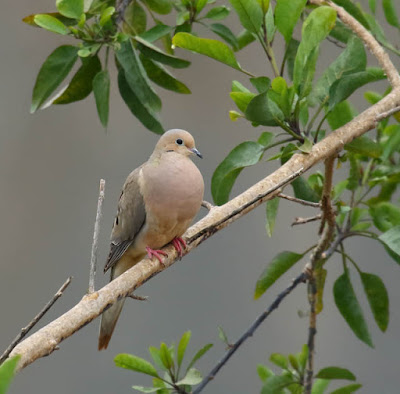 |
| Mourning Dove. Greg Gillson. |
Range in Maine: Mourning Doves are year-round residents throughout Maine.
Identification: This is a key species for comparing with an unknown bird.
Size: About 12 inches long from bill tip to tail tip. About same size as Northern Flicker. Larger than American Robin. Slightly smaller than domestic city pigeon.
Shape: Very plump with a small round head. Tail is long and pointed. Legs are short.
Bill: Small and rather slender.
Color: Pale brown-pink body, darker wings and tail. White edges on side of tail.
Habitat, range & behavior: Semi-open areas such as urban areas, farmlands, woods. Often seen perched on wires, fences.
It is a resident across the lower-48 states and Mexico, with some movement out of northern areas in winter.
Their mournful cooing is a familiar spring birdsong.
Food and feeder preference: Mourning Doves eat seeds almost exclusively. Attract with black oil sunflower seeds on a large sturdy tray feeder or on the ground.
7. American Robin (Turdus migratorius)
This familiar bird is a resident in the northern half of the United States and a winter visitor in the southern half.
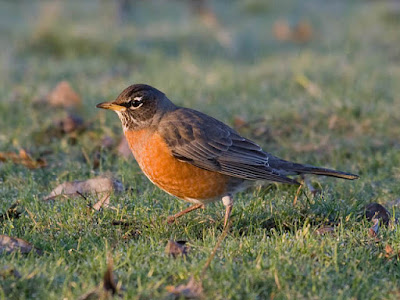 |
| American Robin. Greg Gillson. |
Range in Maine: American Robins are summer residents throughout Maine, year-round residents in southern coastal areas.
Identification: This is a key species for comparing with an unknown bird.
Size: 10 inches long from bill tip to tail tip. About the same size as a Blue Jay or one of the Scrub-Jays. Larger than Red-winged Blackbird. Smaller than a Mourning Dove.
Shape: Very plump with a fairly long tail.
Bill: Straight and fairly slender, curved at the tip.
Color: Gray-brown upperparts, rusty orange breast.
Habitat, range & behavior: Open woodlands, farmlands, urban parks and lawns.
Migratory, breeds north across Alaska and Canada. Resident in most of the United States (lower 48). Winters in the United States, Mexico, to central America.
Hops on your lawn turning head this way and that looking for food. Their caroling song is one of the early signs of spring in the north.
Food and feeder preference: American Robins eat earthworms and other invertebrates in the lawn. May eat fruit from a tray feeder or the ground. Eat small berries from trees and bushes.
8. Northern Cardinal (Cardinalis cardinalis)
This is one of the most common and popular backyard birds in the eastern half of the United States.
 |
| Northern Cardinal. GeorgeB2 from Pixaby |
Range in Maine: Northern Cardinals are year-round residents in southern Maine.
Identification:
Size: Cardinals are a bit smaller than American Robins, about the same size as Red-winged Blackbirds.
Shape: Plump body with fairly long full tail. Wispy crest.
Bill: Short, heavy, conical, pink.
Color: That bright red color is matched by few other birds. Black face. The female is more gray, but with hints of red in wings and tail, and has a crest, too.
Habitat, range & behavior: Cardinals are year-round residents in shrubby woodland edges from the eastern United States to Texas and Arizona south into Mexico.
That large conical bill is made for chewing seeds. Watch them crack open sunflower seeds, spit out the hulls, and pluck the kernel with their tongues!
Food and feeder preference: Black oil sunflower seeds. Many types of seeds, berries, nuts in larger hopper or tray feeders.
You may like my in-depth article on attracting Northern Cardinals.
9. White-breasted Nuthatch (Sitta carolinensis)
A favorite feeder bird for many for its active antics and fearlessness. Though a small bird it is the largest nuthatch in North America.
 |
| White-breasted Nuthatch. Greg Gillson |
Range in Maine: White-breasted Nuthatches are year-round residents throughout Maine.
Identification:
Size: About chickadee-sized in length. Smaller than a junco or House Finch.
Shape: Appears large-headed, neckless, very short tailed. Short legs.
Bill: Nearly as long as head, straight, thin.
Color: Blue-gray above, white below. Black cap, wing tips, tail. Rusty feathers under tail.
Habitat, range & behavior: Common in oak and oak-pine woodlands, wooded towns.
Found across the United States, southern Canada, mountains of central Mexico. Absent from treeless grasslands, deserts in the west.
Crawls over tree branches and head-first down tree trunks searching for insects.
Food and feeder preference: Insects, seeds, acorns and other nuts. Love black oil sunflower seeds feeding on hopper and tray feeders. Suet blocks.
10. Downy Woodpecker (Dryobates pubescens)
This tiny woodpecker is found across the United States.
 |
| Downy Woodpecker. Greg Gillson |
Range in Maine: Downy Woodpeckers are year-round residents throughout Maine.
Identification:
Size: Bigger than a junco or House Finch. Smaller than a Red-winged Blackbird. About the same size as a White-crowned Sparrow, but with a much shorter tail.
Shape: Stocky with large head and short stiff tail.
Bill: Short, chisel-shaped.
Color: Black-and-white striped head. Black wings with white spots. Solid white back. White under parts. Black tail with white outer tail feathers with black bars or spots. Male with small red spot at back of head.
Habitat, range & behavior: Found in small deciduous trees, willows, and even weed stocks such as teasel, especially near water.
Ranges coast-to-coast across all but northernmost parts of Canada and Alaska south to the southern US. Absent in the desert southwest.
Interestingly, I learned today that the males may more often be found in smaller plants and twigs, while females are more likely on tree trunks.
Food and feeder preference: Insects, fruits, and seeds. Gleans arthropods from the bark of trees. Attract with suet feeder. Will also eat black oil sunflower seeds.
11. Tufted Titmouse (Baeolophus bicolor)
Related to chickadees, they lack the black bib, but have a crest instead.
 |
| Tufted Titmouse. anne773 from Pixabay |
Range in Maine: Tufted Titmice are year-round residents in southern and coastal Maine.
Identification:
Size: A small bird, but a large titmouse, this species is larger than chickadees, about the size of a junco or House Finch.
Shape: Rounded body, long full tail, big head, long legs.
Bill: Short and stout, compressed (taller than wide), black.
Color: Dark blue-gray above, pale below. Black feathers around eye accentuates its size.
Habitat, range & behavior: Lives in deciduous forests with heavy canopy, parks.
Found in eastern and southeastern United States is expanding its range north and west.
Food and feeder preference: Insects and seeds. At your hopper or tray feeder they like black oil sunflower seeds and suet.
12. Red-breasted Nuthatch (Sitta canadensis)
These small birds are common in conifer groves and mountain forests.
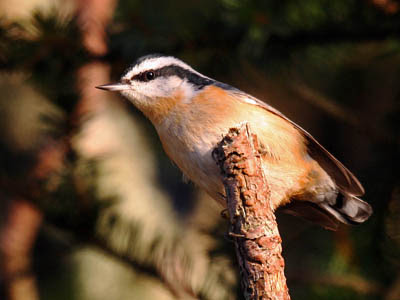 |
| Red-breasted Nuthatch. Greg Gillson. |
Range in Maine: Red-breasted Nuthatches are year-round residents throughout Maine.
Identification:
Size: Smaller than Black-capped Chickadees and American Goldfinches, larger than kinglets.
Shape: Compact body with large head on short neck. Stubby tail.
Bill: Fairly long and sharp-pointed.
Color: Dark blue-gray back and upper parts. Black crown and line through eye, showing long white eyebrow. White face and rusty underparts. Females paler.
Habitat, range & behavior: Conifer trees in forests and residential areas.
Found from Alaska and across Canada, mountains of Northeast and much of the West. Winter visitor south throughout most of the United States.
Crawls actively on bark on tree trunks and around smaller branches, often head-first down the tree.
Food and feeder preference: Eat insects and invertebrates. Cache nuts and seeds in fall to eat later in the winter. At feeders eat sunflower seeds, peanuts, other nuts from hopper and tube feeders, and suet.
13. Red-winged Blackbird (Agelaius phoeniceus)
These noisy flocking birds are most often found in marshes. But in winter they are found in backyards.
 |
| Male Red-winged Blackbird. Greg Gillson. |
 |
| Female Red-winged Blackbird. Greg Gillson. |
Range in Maine: Red-winged Blackbirds are summer residents throughout Maine, year-round residents along the coast.
Identification: This is a key species for comparing with an unknown bird.
Size: About 8-3/4 inches long from bill tip to tail tip. About the size of a Northern Cardinal. Smaller than an American Robin.
Shape: Pot-bellied with a longer bill and flat forehead. Tail average.
Bill: Long and sharp pointed.
Color: Males are black with red and yellow shoulder patch. Females are streaked brown and rusty (sparrow-like but pointed bill and flat forehead).
Habitat, range, and behavior: Cattail marshes and wetlands are their summer habitat. In winter they feed in grain fields.
They breed across most of the North American continent. In winter they withdraw from most of Alaska and Canada.
They are found in colonies in summer and large flocks in winter.
Food and feeder preference: They eat insects in summer. In winter they eat grain and seeds. They visit feeders, more often in large winter flocks, and eat most seeds and suet.
14. Hairy Woodpecker (Dryobates villosus)
Hairy Woodpeckers appear in plumage almost exactly as Downy Woodpeckers. Hairy Woodpeckers are slightly larger with a heavier and longer bill.
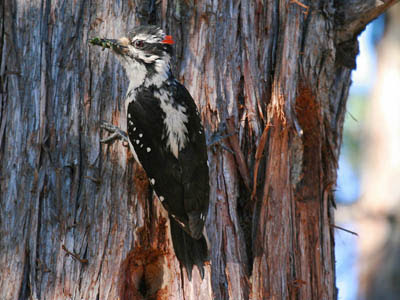 |
| Hairy Woodpecker. Greg Gillson. |
Range in Maine: Hairy Woodpeckers are year-round residents throughout Maine.
Identification:
Size: Slightly larger than Downy Woodpecker. Same size as Red-bellied or Acorn Woodpeckers. Much smaller than flickers.
Shape: Stout body. Large head. Short pointed tail. Short legs, large feet. Short rounded wings.
Bill: Slightly shorter than head. Stout. Chisel-shaped.
Color: Wings and upper parts generally black. White back. Black and white lines on face. Under parts white. Male with red spot on nape.
Habitat, range & behavior: They are found on large trees in open or dense forests.
These birds are widespread across North America except for treeless deserts and grasslands.
These birds are almost always found on trunks or heavy branches of large trees, often conifers. This is different from Downy Woodpeckers which are frequently on small branches, weed stalks, willows.
Food and feeder preference: Eat primarily insects. However, they will come to feeders in winter for suet, peanuts, and sunflower seeds from hopper or platform feeders.
15. Dark-eyed Junco (Junco hyemalis)
Colloquially called “snow birds,” they often arrive in backyards in winter from nearby mountain forests or more northern climes.
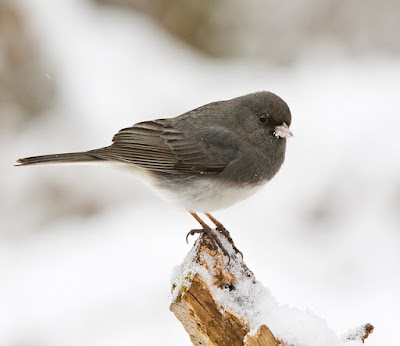 |
| Dark-eyed Junco. skeeze from Pixabay |
Range in Maine: Dark-eyed Juncos are year-round residents throughout Maine.
Identification:
Size: Small birds about the size of a House Finch.
Shape: Round body, short neck, round head, fairly long square-ended tail.
Bill: Short, pointed, conical, pink.
Color: Eastern birds are a darker all-gray with white belly. Western birds have jet black hood over head, brown back, and pink sides.
Habitat, range & behavior: Breed in coniferous forests. Winters widely. Avoids heavy brush, preferring widely spaced bushes.
Breeds across most of Canada, Alaska, and the western half of the United States. Winters from southern Canada and all of the lower 48-states to extreme northern Mexico.
Spend much of their time hopping and feeding on the ground.
Food and feeder preference: Eats mostly seeds, also insects in summer. Readily feed at backyard feeders on mixed seeds on hopper or tray feeders and ground.
You may like my in-depth article on attracting Dark-eyed Juncos.
16. Gray Catbird (Dumatella carolinensis)
This bird is rather common where it occurs, but a bit secretive.

Range in Maine: Gray Catbirds are summer residents throughout Maine.
Identification:
Size: About the length of a Red-winged Blackbird or Northern Cardinal.
Shape: Long tailed, round head.
Bill: Medium-length, pointed.
Color: Gray with a black tail and black cap. Rusty under tail coverts.
Habitat, range & behavior: Dense woodland edges, scrub, abandoned orchards.
Breeds in eastern and central US and adjoining southern Canada. Winters in extreme south US Gulf states, southward in eastern Mexico to Panama.
They spend much time hopping on the ground or in low bushes. They defend a winter territory, unlike most birds.
Food and feeder preference: Insects and berries. You may attract this species with jelly and fruit feeders, suet, and water.
17. Eastern Phoebe (Sayornis phoebe)
This plain bird is common in backyards in the East.

Range in Maine: Eastern Phoebes are summer residents throughout Maine.
Identification:
Size: About the size of bluebirds. Larger than House Sparrows.
Shape: Rather stout, with long wings, medium-length tail. Pointed but flat bill. Upright posture.
Bill: Black, pointed, wide and flat.
Color: Brownish-gray above, slightly yellow-olive on sides. White under tail coverts. No eye ring or wing bars help distinguish them from some other flycatchers.
Habitat, range & behavior: Found in woodlands, suburbs, farms. Frequently nest in rafters, under eaves, porches.
They are summer residents east of the Rocky Mountains from Canada southward. Year-round residents through the interior of the Southeast, to Texas. Winter visitor to Gulf Coast and southern Atlantic.
Phoebes pump their tail down. They also frequently spread their tails.
Food and feeder preference: They eat flying insects that they catch on the wing. Not a feeder visitor.
18. Chipping Sparrow (Spizella passerina)
Chipping Sparrows are a widespread species adapted to human disturbance. They are rather tame. They are frequently found in cemeteries with large trees.
 |
| Chipping Sparrow. Greg Gillson. |
Range in Maine: Chipping Sparrows are summer residents throughout Maine.
Identification:
Size: These are small sparrows, bigger than goldfinches or chickadees, but smaller than House Finches or Song Sparrows.
Shape: Plump and fairly long-tailed.
Bill: Short and conical.
Color: Striped brown and dark brown above. Grayish under parts. Black line through eye. Crown streaked in winter but in summer becomes solid chestnut. Two white wing bars.
Habitat, range & behavior: Grassy open conifer woodlands with some shrubs, parks, orchards.
Breeds from Alaska, across Canada and south into highlands of Middle America. In winter retreats from northern areas to southern United States and northern Mexico.
In summer solitary or in pairs. In winter they forage in flocks of up to 50 birds.
Food and feeder preference: Weed seeds, supplemented with insects in summer. They may eat black oil sunflower seeds in your feeder, but more likely will feed on mixed seeds on the ground under the feeder.
19. White-throated Sparrow (Zonotrichia albicollis)
A fairly common bird of northern forests that visits backyards across much of the US.
 |
| White-throated Sparrow. Greg Gillson |
Range in Maine: White-throated Sparrows are summer residents throughout Maine, year-round residents in coastal Maine.
Identification:
Size: Similar in size to White-crowned Sparrow. Bigger than a House Finch; smaller than a starling.
Shape: Longer body. Round head on short neck. Long tail with notched tip.
Bill: Short. conical.
Color: Striped tan and brown above, pale gray below. White-striped form with black and white head stripes. Tan-striped form with tan and brown striped head. First year birds are similar to tan-stiped adults, but streakier overall. Yellow spot between eyebrow and bill. White throat strongly offset from gray breast and face.
Habitat, range & behavior: Found in forests, brush, and open woodland edges.
Breeds across Canada and northernmost Eastern United States. Winters in the eastern US, southern central US, and rare but regular along the West Coast.
Found in small flocks on ground near brush into which they can flee. Kick up leaves to search under for food.
Food and feeder preference: Eat seeds and berries in winter, more insects and fruit in summer. In your feeder will eat mixed seeds on a platform feeder and on the ground.
20. European Starling (Sturnus vulgaris)
Introduced to North America in the late 1800’s, they crossed the continent, often to the detriment of native cavity-nesting birds. The prime example of an invasive species.
 |
| European Starling. Greg Gillson. |
Range in Maine: European Starlings are year-round residents throughout Maine.
Identification:
Size: About the size of a Red-winged Blackbird. Smaller than an American Robin. Larger than a White-crowned Sparrow or Spotted/Eastern towhee.
Shape: Stocky with large head, short square-ended tail. Longer legs.
Bill: As long as head. Sharp pointed. Yellow in spring, otherwise dark.
Color: They are grayish brown much of the year, with glossy iridescence and white spotting during the spring.
Habitat, range & behavior: Lowland birds that need trees large enough for nest cavities but plenty of open area for feeding. They are most abundant in urban and suburban areas where they find food and artificial nest cavities.
Resident from coast-to-coast from southern Canada to northern Mexico. In summer north across Canada and Alaska. Native range is Europe to Pakistan, north Africa.
Often viewed as a pest, starlings often bully other backyard birds, taking over bird feeders, and stealing nest cavities from smaller native birds.
In winter they can form into flocks of ten’s of thousands.
Food and feeder preference: European Starlings eat primarily insects when available, often feeding on the ground. Discourage them from your backyard hopper and tray feeders by never feeding birds table scraps (including bread or meat). They have weak feet and do not perch well on tube feeders. A cage mesh around smaller hopper feeders may keep them out.
21. Common Grackle (Quiscalus quiscula)
Sometimes considered a pest to crops, grackles are longer and lankier than very similar blackbirds.
 |
| Common Grackle. GeorgiaLens from Pixabay |
Range in Maine: Common Grackles are summer residents throughout Maine, year-round residents in southernmost Maine.
Identification:
Size: Larger than Red-winged Blackbirds, they are near the length of Mourning Doves.
Shape: Long, with long full keel-shaped tail, long legs, flat crown.
Bill: Longer than head, pointed, but stouter than other blackbirds.
Color: Glossy black with hint of bronze or green on head (depending upon population). Yellow eye.
Habitat, range & behavior: They are found in agricultural areas, woodland edges, city parks and lawns.
Resident in the southeastern United States. In summer they migrate northward and west to the central United States and Canada.
They monopolize feeders and are bullies toward other birds.
Food and feeder preference: Grain, corn, acorns, small aquatic fish and amphibians. To discourage them, use tube feeders, rather than hopper or tray feeders. Don’t over-feed, keep spilled seed picked up.
22. Red-eyed Vireo (Vireo olivaceus)
This is one of the most common songbirds in eastern woodlands.

Range in Maine: Red-eyed Vireos are summer residents throughout Maine.
Size: Small, about the size of an American Goldfinch. Smaller than a House Finch.
Shape: Long and slim, but with rather short tail. Big-looking head.
Bill: Longer, stout. Pointed but small hook on end, as all vireos.
Color: They are olive-green above, white or with a hint of yellow below. Gray crown, bordered by black line, white eyebrow, and another thin black line through red eye.
Habitat, range & behavior: Tall deciduous trees, such as cottonwoods.
Breed across Canada, the Rocky Mountains and most of the East. Absent from much of the West and Southwest.
As with many vireos, they sing persistently through the summer and through the heat of the day, not just primarily during spring and at dawn as many other songbirds.
Food and feeder preference: They eat insects and will not come to feeders.
23. Cedar Waxwing (Bombycilla cedrorum)
Waxy red tips to the wing feathers give these birds their unique name. Maybe it’s the fancy crest. Maybe it’s the bandit mask. Maybe it’s the yellow band at the tip of its tail. But these are one of my favorite birds.
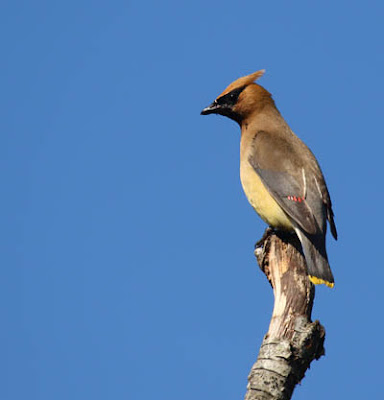 |
| Cedar Waxwing. Greg Gillson. |
Range in Maine: Cedar Waxwings are summer residents throughout Maine, year-round residents in central and southern Maine.
Identification:
Size: Smaller than European Starling. Larger than House Sparrow.
Shape: Similar to European Starling. Rather stocky. Short squared tail, but long under tail coverts. Large head. Pointed wings. Wispy crest.
Bill: Rather short, small, wide.
Color: Warm brown above with wispy crest. Black mask. Yellowish belly. White under tail coverts. Gray wings. Gray tail with yellow tip.
Habitat, range, & behavior: Deciduous woods, wooded streams and lakeshores, residential shade trees, fruit orchards.
Resident across the northern US. Summer resident in Canada. Winter visitor throughout all of US and Mexico.
Keep in tight flocks. Feed in trees and large bushes for berries. Fly catch over ponds and streams.
Food and feeder preference: Berries and flying insects. Usually don’t come to feeders unless fruit like cherries offered, but will visit bird baths.
24. Barn Swallow (Hirundo rustica)
These swallows are widely distributed throughout the world, primarily breeding in the northern hemisphere, and wintering in the mid-latitudes and southern hemisphere.
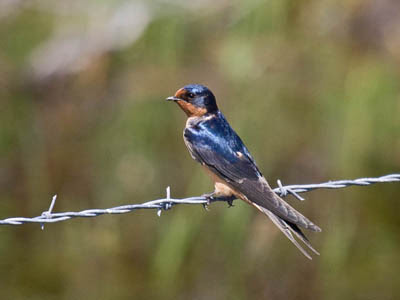 |
| Barn Swallow. Greg Gillson. |
Range in Maine: Barn Swallows are summer residents throughout Maine.
Identification:
Size: About the size of a House Finch but with a much longer tail.
Shape: Stocky, short necked but with long body and tail. Tail is forked, with very long outer tail feathers. Wings pointed.
Bill: Short, wide.
Color: Glossy dark purplish-blue above. Pinkish-orange below.
Habitat, range & behavior: Barn Swallows live in open country, frequently near humans. Farmlands. Nest in barns, under small bridges.
In North America breed from Mexico to northern Canada and Alaska, wintering from southern Mexico throughout most of South America.
Frequently seen swooping low over the ground hunting flying insects. Perch on wires, fences. Voice is twitters and chirps with grating sounds.
Food and feeder preference: Eat flying insects on the wing and are not attracted to backyard feeders.
Common Birds in Maine
To determine how common each species is I used the data from actual bird sightings from the citizen science program eBird. Birds are listed by frequency. That is, how often the species is recorded on checklists submitted to eBird (a percentage).
When choosing the birds to include in this article I leaned strongly to birds that are present throughout the year in good numbers. Thus, many of the common birds are
year-round residents. This means that they live in the same location all year. They raise their young in your neighborhood. They don’t migrate. Or if the species does migrate, the ones living in your area don’t. If this is the case, some migrants may move into your area during certain times of year, adding to the same species that are in your yard full time.
Some migrant birds visit your yard during the “summer.” Often, they arrive in spring and remain until late fall. They nest and raise their young in your neighborhood. These are the summer residents.
Other migrant birds visit your backyard during the “winter.” Some of these winter visitors may arrive in July and remain into April. Others may only be found in the cold of December or January. They key here is that they nest and raise their young somewhere else. They only visit your yard in the non-breeding season.
Migration is an amazing spectacle. There will be birds that fly through your region in spring or fall (or both). They may visit your backyard only a few days or weeks a year. They aren’t regular enough, or stay long enough, to be included in this article. But the number of briefly visiting migrant birds could double the number of species presented here. You may see them over time. Consult checklists in eBird for your county to see what is possible.
I have generally excluded common waterfowl, birds of prey, shorebirds, seabirds, and others that aren’t usually found in residential areas. But they may certainly fly over or be seen regularly if your home is on a shoreline, for instance.
Most common backyard birds in Maine throughout the year
The following list is the backyard birds that are, on average, most common throughout the entire year. The list is ordered by most common based on the frequency of how often each species is recorded on checklists submitted to eBird.
- American Crow (49% frequency)
- Black-capped Chickadee (47%)
- American Goldfinch (36%)
- Blue Jay (34%)
- Song Sparrow (33%)
- Mourning Dove (29%)
- American Robin (29%)
- Northern Cardinal (22%)
- White-breasted Nuthatch (21%)
- Downy Woodpecker (21%)
- Tufted Titmouse (18%)
- Red-breasted Nuthatch (16%)
- Red-winged Blackbird (16%)
- Hairy Woodpecker (16%)
- Dark-eyed Junco (14%)
- Gray Catbird (14%)
- Eastern Phoebe (14%)
- Chipping Sparrow (13%)
- White-throated Sparrow (13%)
- European Starling (13%)
- Common Grackle (12%)
- Red-eyed Vireo (12%)
Most common backyard birds in Maine in winter
- Black-capped Chickadee (52% frequency)
- American Crow (48%)
- Blue Jay (31%)
- White-breasted Nuthatch (28%)
- American Goldfinch (27%)
- Downy Woodpecker (26%)
- Mourning Dove (26%)
- Tufted Titmouse (23%)
- Northern Cardinal (22%)
- Hairy Woodpecker (20%)
- Dark-eyed Junco (20%)
- Red-breasted Nuthatch (15%)
- European Starling (13%)
Most common backyard birds in Maine in summer
- Song Sparrow (45% frequency)
- American Crow (39%)
- American Goldfinch (38%)
- American Robin (37%)
- Red-eyed Vireo (34%)
- Black-capped Chickadee (34%)
- Mourning Dove (27%)
- Blue Jay (27%)
- Gray Catbird (23%)
- Cedar Waxwing (23%)
- Red-winged Blackbird (22%)
- Chipping Sparrow (21%)
- Common Grackle (17%)
- Eastern Phoebe (16%)
- Red-breasted Nuthatch (15%)
- White-throated Sparrow (15%)
- Barn Swallow (12%)
- White-breasted Nuthatch (12%)
How do backyard birds compare between summer and winter in Maine?
Song Sparrows, American Goldfinches, American Robins, Red-eyed Vireos, Gray Catbirds, Cedar Waxwings, Chipping Sparrows, Barn Swallows are more common in summer than winter.
American Crows, Black-capped Chickadees, White-breasted Nuthatches, Downy Woodpeckers, Tufted Titmice, Northern Cardinal are more common in winter than in summer.
Common Backyard Birds of Augusta, Maine
- American Crow (57% frequency)
- Black-capped Chickadee (55%)
- American Goldfinch (49%)
- Blue Jay (44%)
- Mourning Dove (43%)
- White-breasted Nuthatch (38%)
- Song Sparrow (34%)
- American Robin (33%)
- Northern Cardinal (31%)
- Downy Woodpecker (30%)
- Tufted Titmouse (28%)
- Hairy Woodpecker (24%)
- Red-winged Blackbird (22%)
American Crows, American Goldfinches, Blue Jays, Mourning Doves, White-breasted Nuthatches, Northern Cardinal, Tufted Titmice are more common in Augusta, on average, than the state as a whole.
Common Backyard Birds of Portland, Maine
- American Crow (58% frequency)
- Black-capped Chickadee (50%)
- American Goldfinch (42%)
- Song Sparrow (39%)
- Blue Jay (34%)
- Northern Cardinal (34%)
- Mourning Dove (32%)
- American Robin (30%)
- Tufted Titmouse (29%)
- White-breasted Nuthatch (26%)
- Downy Woodpecker (25%)
- Red-winged Blackbird (21%)
American Crows, Northern Cardinals, Tufted Titmice are more common in Portland, on average, than in the state as a whole.
Common Backyard Birds of Lewiston, Maine
- Black-capped Chickadee (59% frequency)
- American Crow (52%)
- American Goldfinch (41%)
- Blue Jay (40%)
- Mourning Dove (39%)
- White-breasted Nuthatch (35%)
- Northern Cardinal (33%)
- Tufted Titmouse (32%)
- American Robin (31%)
- Downy Woodpecker (30%)
- Song Sparrow (29%)
- Chipping Sparrow (19%)
- Hairy Woodpecker (19%)
- European Starling (19%)
Black-capped Chickadees, Mourning Doves, White-breasted Nuthatches, Northern Cardinals, Tufted Titmice, Downy Woodpeckers are more common in Lewiston, on average, than in the state as a whole.
Wrapping Up
Maine has great opportunities for bird watching in your backyard but if you are feeling adventurous, why not head out and explore the state further. Here are some common birds you might find:
Forests:
- Interior & Southern Maine (Red Oak and White Pine): American Bittern, Green Heron, Virginia and Sora Rails, Black Duck, Wood Duck, Yellow Warbler, Northern Waterthrush, Red-winged Blackbirds, Swamp Sparrows.
- Northern Maine (Boreal Forests): Spruce Grouse, Yellow-bellied Sapsucker, Blackpoll Warbler, Pine Siskin, Common Raven, Gray Jay.
Wetlands:
- Salt Marshes: Clapper Rail, Nelson’s Sparrow, Saltmarsh Sparrow, Seaside Sparrow, Common Tern, Black Skimmer.
- Freshwater Marshes: American Bittern, Pied-billed Grebe, Common Loon, Green Heron, Mallard, Black Duck, Northern Pintail, Red-winged Blackbird, Swamp Sparrow.
Open Fields and Grasslands:
- Fields: Bobolink, Eastern Meadowlark, Savannah Sparrow, Grasshopper Sparrow, Killdeer, Northern Harrier.
- Coastal Meadows: Short-billed Dowitcher, Common Moorhen, American Oystercatcher, Willet, Upland Sandpiper.
Rocky Shores:
- Sea Cliffs: Atlantic Puffin, Razorbill, Common Murre, Black Guillemot, Northern Gannet, Herring Gull.
- Jetties and Breakwaters: Rock Dove, Black-crowned Night-Heron, Common Eider, Surf Scoter, Black Guillemot, Double-crested Cormorant.
Frequently Asked Questions
What is the state bird of Maine?
The state bird of Maine is the Black-capped Chickadee! These charming little birds with their distinctive black cap, white cheeks, and friendly “chick-a-dee-dee” call are common year-round residents throughout the state, from dense forests to backyard feeders. They were chosen as the state bird in 1927, likely due to their widespread presence and association with the wintery character of Maine.
The Black-capped Chickadee plays an important role in the Maine ecosystem, helping control insect populations and dispersing seeds of various plants. Their remarkable ability to store food in hidden caches helps them survive throughout the harsh winter months.
What is the blue headed bird in Maine?
The Blue-headed Vireo is a summer resident in Maine, meaning you can find them from late April to early September. These birds prefer mature mixed forests with a good mix of coniferous and deciduous trees, especially hemlock and spruce. Look for them in the canopy layer, foraging for insects high in the leaves.
Here are some specific places where you might encounter Blue-headed Vireos in Maine:
- Coastal islands: Monhegan Island, Great Cranberry Island, Isle au Haut
- Inland areas: Baxter State Park, Acadia National Park, Katahdin Woods and Waters National Monument, Moosehorn National Wildlife Refuge
- Large state forests: Perkins Tract, Bigelow Mountain, Baxter State Park, Penobscot Bay State Park
Tips for finding Blue-headed Vireos:
- Listen for their song: It’s a slow, deliberate series of whistled phrases, often described as “who-who-who-see-see-me,” with a rising inflection.
- Look for them in the canopy: They forage and nest high in the trees, so you might need binoculars to get a good look.
- Visit their preferred habitat: Focus on mature mixed forests with tall trees and dense foliage.
- Go birding early in the morning: They are most active at dawn and dusk.
What is a black and white bird with a red chest in Maine?
The Rose-breasted Grosbeak is a striking bird that has a black head and back, white wing patches and underparts, and a triangular red chest. They are common visitors to backyards and open woodlands during the breeding season (May-September).

Related Articles:
34 of the most common birds in the United States (with photos)
Red, Orange, & Yellow Birds of Maine











Thank you! Very helpful!
You are welcome. Thanks for visiting!